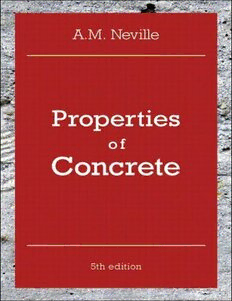
Properties of Concrete PDF
Preview Properties of Concrete
Properties of concrete Fifth Edition A. M. Neville CBE, DSc(Eng), DSc, FIStructE, FREng, FRSE Honorary Member of the American Concrete Institute Honorary Member and Gold Medallist of the Concrete Society Honorary Member of the Brazilian Concrete Institute formerly Head of Department of Civil Engineering, University of Leeds, England Dean of Engineering, University of Calgary, Canada Principal and Vice-Chancellor, University of Dundee, Scotland President of the Concrete Society Vice-President of the Royal Academy of Engineering Harlow, England • London • New York • Boston • San Francisco • Toronto • Sydney • Singapore • Hong Kong Tokyo • Seoul • Taipei • New Delhi • Cape Town • Madrid • Mexico City • Amsterdam • Munich • Paris • Milan Pearson Education Limited Edinburgh Gate Harlow Essex CM20 2JE England and Associated Companies throughout the world Visit us on the World Wide Web at: http://www.pearsoned.co.uk © A M Neville 1963, 1973, 1975, 1977, 1981, 1995, 2011 The rights of A M Neville to be identified as the author of this work has keen asserted by him in accordance with the Copyright, Designs, and Patents Act 1988. All rights reserved; no part of this publication may be reproduced, stored in any retrieval system, or transmitted in any form or by any means, electronic, mechanical, photocopying, recording or otherwise without either the prior written permission of the Publishers or a licence permitting restricted copying in the United Kingdom issued by the Copyright Licensing Agency Ltd, 90 Tottenham Court Road. London WIT 4LP First published 2011 ISBN: 978-0-273-75580-7 British Library Cataloguing in Publication Data A catalogue entry for this title is available from the British Library. Library of Congress Cataloging-in-Publication Data Neville, Adam M. Properties of concrete / A.M. Neville. -- 5th ed. p. cm. ISBN 978-0-273-75580-7 (pbk.) 1. Concrete. I. Title. TA439.N48 2011 620.1′36--dc23 2011019819 Set by 35 in 10/12 Monotype Times Printed in Malaysia (CTP-VVP) 5 4 3 2 1 15 14 13 12 11 Contents Preface to the Fifth Edition Preface Acknowledgements 1 Portland cement Historical note Manufacture of Portland cement Chemical composition of Portland cement Hydration of cement Calcium silicate hydrates Tricalcium aluminate hydrate and the action of gypsum Setting False set Fineness of cement Structure of hydrated cement Volume of products of hydration Capillary pores Gel pores Mechanical strength of cement gel Water held in hydrated cement paste Heat of hydration of cement Influence of the compound composition on properties of cement Effects of alkalis Effects of glass in clinker Tests on properties of cement Consistency of standard paste Setting time Soundness Strength of cement References 2 Cementitious materials of different types Categorization of cementitious materials Different cements Ordinary Portland cement Rapid-hardening Portland cement Special very rapid-hardening Portland cements Low heat Portland cement Sulfate-resisting cement White cement and pigments Portland blastfurnace cement Supersulfated cement Pozzolanas Fly ash Pozzolanic cements Silica fume Fillers Other cements Which cement to use High-alumina cement Manufacture Composition and hydration Resistance to chemical attack Physical properties of high-alumina cement Conversion of high-alumina cement Refractory properties of high-alumina cement References 3 Properties of aggregate General classification of aggregates Classification of natural aggregates Sampling Particle shape and texture Bond of aggregate Strength of aggregate Other mechanical properties of aggregate Specific gravity Bulk density Porosity and absorption of aggregate Moisture content of aggregate Bulking of fine aggregate Deleterious substances in aggregate Organic impurities Clay and other fine material Salt contamination Unsound particles Soundness of aggregate Alkali–silica reaction Tests for aggregate reactivity Alkali–carbonate reaction Thermal properties of aggregate Sieve analysis Grading curves Fineness modulus Grading requirements Practical gradings Grading of fine and coarse aggregates Oversize and undersize Gap-graded aggregate Maximum aggregate size Use of ‘plums’ Handling of aggregate Special aggregates Recycled concrete aggregate References 4 Fresh concrete Quality of mixing water Density of fresh concrete Definition of workability The need for sufficient workability Factors affecting workability Measurement of workability Slump test Compacting factor test ASTM flow test Remoulding test Vebe test Flow table test Ball penetration test and compactability test Nasser’s K-tester Two-point test Comparison of tests Stiffening time of concrete Effect of time and temperature on workability Segregation Bleeding The mixing of concrete Concrete mixers Uniformity of mixing Mixing time Hand mixing Ready-mixed concrete Retempering Pumped concrete Concrete pumps Use of pumping Requirements for pumped concrete Pumping lightweight aggregate concrete Shotcrete Underwater concrete Preplaced aggregate concrete Vibration of concrete Internal vibrators External vibrators Vibrating tables Other vibrators Revibration Vacuum-dewatered concrete Permeable formwork Analysis of fresh concrete Self-compacting (self-consolidating) concrete References 5 Admixtures Benefits of admixtures Types of admixtures Accelerating admixtures Retarding admixtures Water-reducing admixtures Superplasticizers Nature of superplasticizers Effects of superplasticizers Dosage of superplasticizers Loss of workability Superplasticizer–cement compatibility Use of superplasticizers Special admixtures Waterproofing admixtures Anti-bacterial and similar admixtures Remarks about the use of admixtures References 6 Strength of concrete Water/cement ratio Effective water in the mix Gel/space ratio Porosity Cement compacts Influence of properties of coarse aggregate on strength Influence of aggregate/cement ratio on strength Nature of strength of concrete Strength in tension Cracking and failure in compression Failure under multiaxial stress Microcracking Aggregate–cement paste interface Effect of age on strength of concrete Maturity of concrete Relation between compressive and tensile strengths Bond between concrete and reinforcement References
